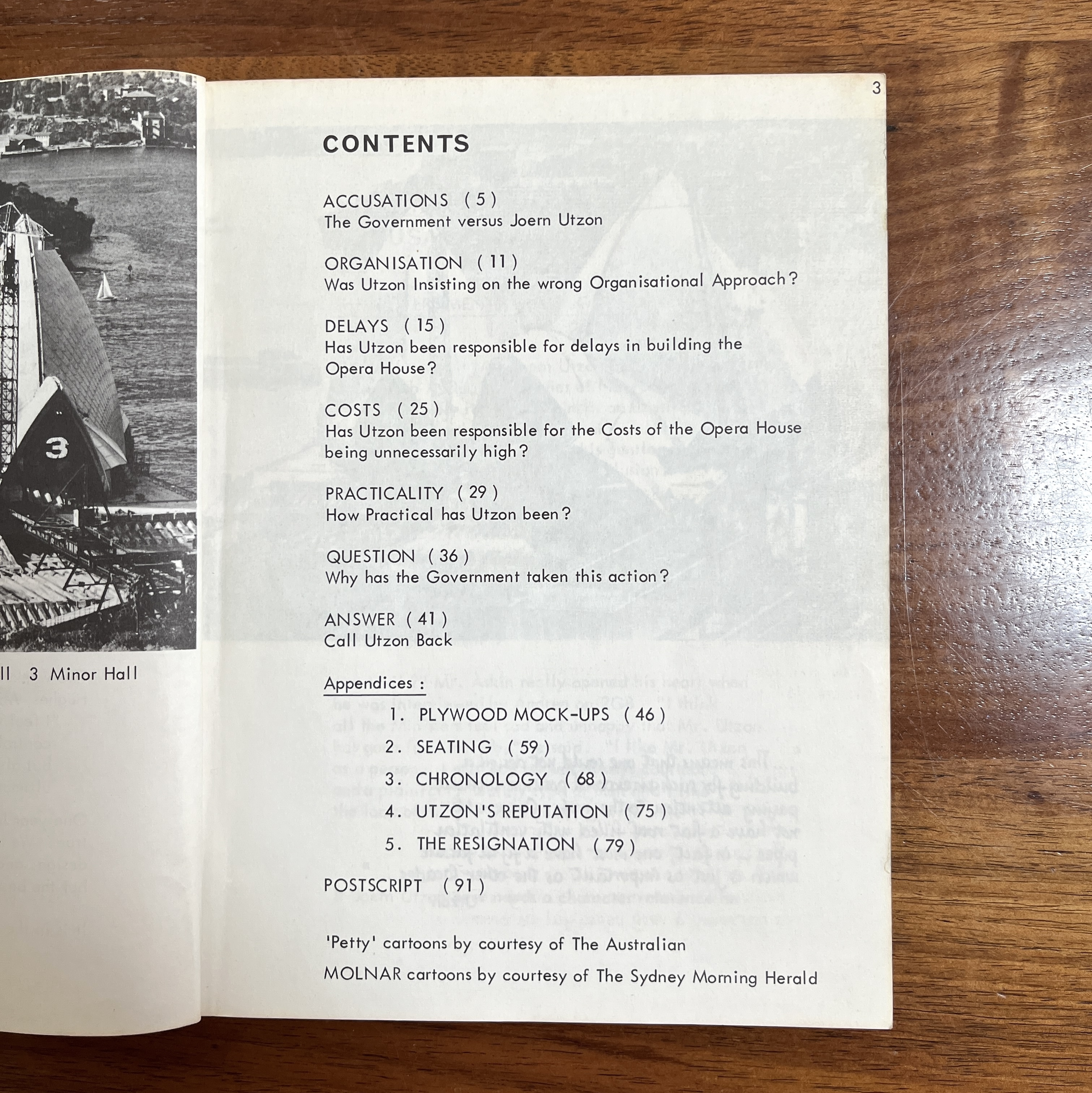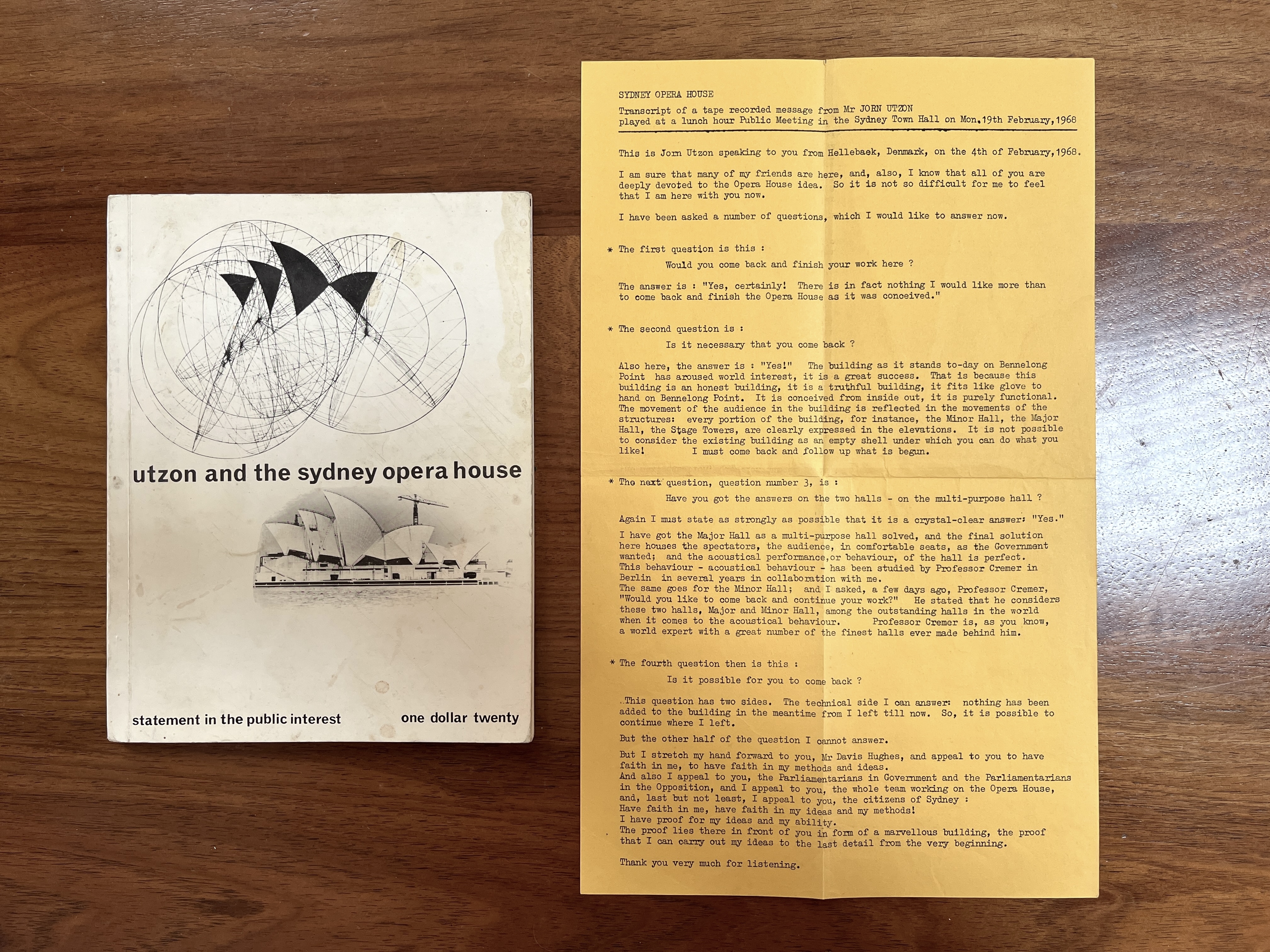On the weekend I took one of my book-loving sons (yes, the book is far from dead) to the annual Lifeline book fair. Whilst we usually spend most of the time trawling through the ‘Junior’ section, I can’t seem to leave without looking at the (small) architecture section. Always hoping to unearth something unusual. This year – just three boxes. But have a look what was tucked away in one:

There is in fact nothing I would like more than to come back and finish the Opera House as it conceived – Jørn Utzon, February 1968

Utzon and the Sydney Opera House : statement in the public interest by Elias Duek-Cohen (1967)
A significant book to me for a few reasons; it’s a contemporary (1967) book about Utzon and the Opera House, it has lots of illustrations, and sadly the author, Elias Duek-Cohen, passed away in 2014.
1968 Utzon Transcript
Slipped inside the cover of the book was a folded colour foolscap page with a typewritten transcript of a recorded message by Utzon! Not sure if this was inserted into every book at the time or placed there by the former owner in the late 1960s.

Anyway, with the power of Apple’s on-device neural network here’s the full transcript with the original formatting retained…
SYDNEY OPERA HOUSE Transcript of a tape recorded message from Mr JORN UTZON played at a lunch hour Public Meeting in the Sydney Town Hall on Mon. 19th February, 1968 This is Jorn Utzon speaking to you from Hellebaek, Denmark, on the 4th of February, 1968. I am sure that many of my friends are here, also, I know that all of you are deeply devoted to the Opera House idea. So it is not so difficult that I am here with you now. I have been asked a number of questions, which I would like to answer now. * The first question is this : Would you come back and finish your work here ? The answer is: "Yes, certainly! There is in fact nothing I would like more than to come back and finish the Opera House as it conceived." * The second question is : Is it necessary that you come back ? Also here, the answer is : "Yes!"! The building as it stands to-day on Bennelong Point has aroused world interest, it is a great success. What is because this building is an honest building, it is a truthful building, it fits like glove to name on Bennelong Point. It is conceived from inside out, it is purely functional. The movement of the audience in the building is reflected in the movements of the structures: every portion of the building, for instance, the Minor Hall, the Major Hall, the Stage Towers, are clearly expressed in the elevations. It is not possible to consider the existing building as an empty shell under which you can do what you like! I must come back and follow up what is begun. * The next question, question number 3, is : Have you got the answers on the two halls - on the multi-purpose hall ? Again I must state as strongly as possible that it is a crystal-clear answer: "Yes." I have got the Major Hall as a multi-purpose hall solved, and the final solution here houses the spectators, wanted: the audience, in comfortable seats, as the Government and the acoustical performance, or behaviour, of the hall is perfect. This behaviour - acoustical behaviour - has been studied by Professor Cremer in Berlin in several years in collaboration with me. The same goes for the Minor Hall; and I asked, a few days ago, Professor Cremer, "Would you like to come back and continue your work?" He stated that he considers these two halls, Major and Minor Hall, among the outstanding halls in the world when it comes to the acoustical behaviour. Professor Cremer is, as you know, a world expert with a great number of the finest halls ever made behind him. * The fourth question then is this : Is it possible for you to come back ? This question has two sides. The technical side I can answer: nothing has been added to the building in the meantime from I left till now. So, it is possible to continue where I left. But the other half of the question I cannot answer. But I stretch my hand forward to you, Mr Davis Hughes, and appeal to you to have faith in me, to have faith in my methods and ideas. And also I appeal to you, the Parliamentarians in Government and the Parliamentarians in the Opposition, and I appeal to you, the whole team working on the Opera House, and, last but not least, I appeal to you, the citizens of Sydney : Have faith in me, have faith in my ideas and my methods! I have proof for my ideas and my ability. The proof lies there in front of you in form of a marvellous building, the proof that I can carry out my ideas to the last detail from the very beginning. Thank you very much for listening.
Enlightening to read his words as he reflects a few years after he was pushed out in 1966 by the NSW Government of the time. He clearly wants to return…
There are plenty of others (you know, proper authors) who’ve written about his unceremonious exit as the architect of the Sydney Opera House, so I’d encourage you start here and then head here for more.
If you’ll excuse me, I’m off to start reading the rest of the book…
(ps. as far as I’m aware, I’m not related to Lionel Todd, of the consortium Hall, Todd and Littlemore, who had the enormous task of taking over from Utzon. Read more here about the process)
Resources
- Library catalogue details for the book – if you want to track down a copy for yourself
- Elias Duek-Cohen’s obituary and one on the UNSW site that mentions the book.
- The Opera House Project for contemporary transcripts and audio
- The Man Who Wasn’t There an almost 4,000 word piece by Sylvia Lawson on the ousting of Utzon